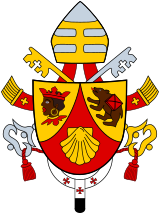Corbinian
Saint Corbinian | |
|---|---|
Saint Corbinian (
Life
Corbinian was born and baptized as Waldegiso at Châtres, near Melun, in Frankish territory. He was named after his father, who may have died when Corbinian was an infant. Soon after his father's death, his mother Corbiniana[2] renamed Waldegiso to "Corbinian", after herself.[3] Nothing else is known of his childhood. The early source for Corbinian's life is the Vita Corbiniani of Bishop Arbeo of Freising.[4]
He lived in Châtres on the road to
On a mountain near

Soon after settling, Corbinian denounced Grimoald's marriage to his brother's widow, Biltrudis, though Grimoald had already repented of his incest. This incited his anger and the chagrin of his wife, who excoriated Corbinian, labeling him a foreign interloper. Finally, she arranged to have him murdered. Corbinian fled Freising until Grimoald was killed and Biltrudis carried off by invaders in 725.[3] Corbinian returned on the invitation of Grimoald's successor, Huebert,[8] and continued his apostolic labors at Freising until his own death in 730.
Corbinian's body, buried at Merano, was translated to Freising in 769 by the aforementioned Bishop Arbeo, author of Corbinian's vita, and is now entombed in Freising Cathedral.
Corbinian's bear
Corbinian's symbol is the saddled
In Catholic iconography

Corbinian's Bear is used as the symbol of Freising in both civic and ecclesiastical
The scallop shell is a traditional reference to pilgrimage. For Pope Benedict XVI, it also reminded him of the legend according to which one day St. Augustine, pondering the mystery of the Trinity, saw a child at the seashore playing with a shell, trying to put the water of the ocean into a little hole. Then he heard the words: This hole can no more contain the waters of the ocean than your intellect can comprehend the mystery of God. The crowned Moor is a regional motif in heraldry often seen in Bavaria, Benedict's German homeland. Benedict has been quoted saying that, in addition to the obvious reference back to Saint Corbinian, the founder of the diocese where Benedict would become bishop in 1977, the bear represents Benedict himself being "tamed by God" to bear the spiritual burdens of Benedict's own ministries first as bishop, then as cardinal, and now as pope.[12]
Gallery
Scenes from the life of Saint Corbinian from a panel in the crypt of Freising Cathedral.
-
S. Corbinianus adolescens - Castri vitam solitariam agit - Saint Corbinian as a young man decides upon a life of holy solitude
-
St. Corbinianus Romam venit et episcopus creatur - Saint Corbinian travels to Rome and is created a bishop
-
St. Corbinianus Adalbertum a supplicio liberat - Saint Corbinian frees Adalbert at his humble entreaty
-
Sanctus Corbinianus urso sarcinas imponit - Saint Corbinian commands the bear to carry his luggage
-
S. Corbinianus a Grimoaldo honorifice excipitur - Saint Corbinian respectfully received by Grimoald
-
Sanctus Corbinian' Frisingae populum docet - Saint Corbinian teaches the people of Freising
-
Sanct' Corbinian' spiritum sanctissime reddit - Saint Corbinian solemnly gives up his spirit
-
S. Corbiniani reliquiae Frisingam transferuntur - The relics of Saint Corbinian are transferred to Freising
Further reading
- Vogel, Lothar (June 2000). Vom Werden eines Heiligen: Eine Untersuchung der Vita Corbiniani des Bischofs Arbeo von Freising. Walter de Gruyter. ISBN 3-11-016696-8.
Notes
- ^ a b c Jones, Terry. "Saint Corbinian". Patron Saints Index. Archived from the original on 2007-02-17. Retrieved 2007-01-04.
- ^ See Helmut Zenz: Heiliger Korbinian im Internet Archived 2013-10-19 at the Wayback Machine (Retrieved on 2007-01-06), in which Corbinian's mother is referred to as "Corbiniana". (German - Nach dem Tod seiner Mutter Corbiniana lebte er als Eremit bei der Kirche von Saint-Germain bei Châtres. English - "After the death of his mother Corbiniana he lived as a hermit in the church of Saint Germain in Châtres")
- ^ a b Staley, Tony (2004-09-03). "From recluse to missionary". The Compass. Retrieved 2007-01-04.
- ^ Published in Scriptores rerum Germanicarum 13, Monumenta Germaniae Historica. The writings of Arbeo are of broader significance, as all but the only examples of the Latin used in Bavaria before the Carolingian literary reforms. The modern study is Lothar Vogel, 2000. Vom Werden Eines Heiligen: Eine Untersuchung Der Vita Corbiniani Des Bischofs Arbeo Von Freising (series "Arbeiten Zur Kirchengeschichte". Walter De Gruyter).
- ^ Rabenstein, Katherine. "Corbinian of Freising". Saint o' the Day (8 September). Archived from the original on December 5, 2006. Retrieved 2012-02-23.
{{cite web}}: CS1 maint: unfit URL (link) - ^ "Freising". Encyclopædia Britannica. 2007. Retrieved 2007-01-04.
- ^ "Munich-Freising". Catholic Encyclopedia. Vol. 10. Robert Appleton Company. 1911. Retrieved 2007-01-04.
- ^ "St. Corbinian". Catholic Encyclopedia. Vol. 4. Robert Appleton Company. 1908. Retrieved 2007-01-04.
- ^ a b "The bear and the scallop-shell - a unique papal coat of arms". Catholic World News. 2005-04-27. Retrieved 2007-01-05.
- ^ "The Coat of Arms of His Holiness Benedict XVI". Vatican. Archived from the original on 2007-01-10. Retrieved 2007-01-05.
- ^ "L'Osservatore Romano publishes new Papal coat of arms". Catholic News Agency. 2005-04-28. Retrieved 2007-01-05.
- ISBN 0-7394-5626-1(hardcover); 0898707021 (paperback).
External links
- Munich-Freising at Catholic Encyclopedia
- (in German) Helmut Zenz: Heiliger Korbinian im Internet includes a gallery of images, a timeline of Corbinian's life, and sources in many languages for further reading
- (in Norwegian) Den hellige Korbinian av Freising
- (in French) Saint Corbinien - Evêque fondateur de l'église en Bavière includes hagiography for Corbinian and pictures of tapestries depicting the story of his life
- Butler, Alban. "St. Corbinian, Bishop of Frisingen, Confessor", Lives of the Saints, Vol. IX, (1866)








